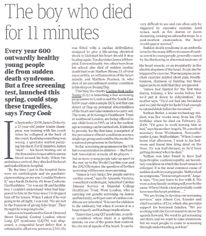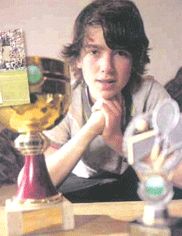Every year 600 outwardly healthy young people die from sudden death syndrome. But a free screening test, launched this spring, could stop these tragedies, says Tracy Cook.
In September 2008, James Doherty, a 13-year-old junior tennis champion, was training with his coach when he collapsed at the back of the court. Realising something was wrong, a spectator started pumping his chest. For 11 minutes, James “died” – his heart beating out of rhythm and no longer ale to pump blood around his body. When the ambulance arrived, they shocked his heart and rushed him to hospital.
“By the time I got to the hospital there were six cardiologists and six paediatricians working on my son. I couldn’t believe it”, says Sarah Doherty, 49, from Codicote, Hertfordshire. “He was my fit and healthy boy. I couldn’t understand what had happened to him in the time since I’d dropped him off for tennis. When I asked if he was going to be all right, I was told, ‘We are not in the business of giving false hope.’ They thought he was going to die.”
James was transferred to Great Ormond Street Hospital, Central London, where Long QT syndrome (LQTS) was diagnosed, a congenital heart defect that is estimated to affect one person in 2,500. He was fitted with a cardiac defibrillator, designed to give a life-saving electrical shock to kick-start his heart should it stop beating again. Ten days later James left hospital. Extraordinarily, two other boys from his school also died of sudden cardiac death that year. Mathew Blease, 13, of viral myocarditis, an inflammation of the heart muscle, and Matthew Pearson, 14, who died of an unconfirmed cardiac condition in his sleep on Boxing Day.
This May, the charity Cardiac Risk in the Young (CRY) is launching a free screening programme in London and the South East for 14-year-olds; a simple ECG test that can detect or flag-up potential abnormalities of the heart and takes minutes to carry out. The tests, at St George’s Healthcare Trust in southwest London, are being offered to any child born in 1995, as 14 is the earliest age screening can be carried out. It intends to provide, for the first time, a snapshot of the prevalence of heart conditions across a single age group and could be the model for a national programme in the future.
So far, screening programmes in the UK have concentrated on athletes – the Football Association screens all its players, but as more young people take up sport in the run-up to the World Cup this year and the 2012 Olympics, the question of further screening will become more pressing.
“James is very lucky; few people survive cardiac arrest,” says Dr Amanda Varnava, consultant cardiologist, Inherited Cardiac Disease Service at Imperial College Healthcare Trust, West London, who is carrying out genetic screening on James and his family, as 80 per cent of cardiac conditions are inherited. “It’s rare for children to die suddenly, but when it occurs it is a huge tragedy and has huge implications.
James has Long QT syndrome, a cardiac condition where there is a spelling mistake on one of the genes that controls the electrical signals of the heart. It can be very difficult to see and can often only be triggered by excessive exercise, loud noises, such as fire alarms or door slamming, causing an adrenalin surge. In a post-mortem examination, the heart would appear normal.”
Sudden death syndrome is an umbrella terms for the many different causes of cardiac arrest in young people, generally caused by the thickening or abnormal anatomy of the heart muscle, or abnormal anatomy of the heart muscle, or an irregularity in the electrical system of the heart. It can also be triggered by exercise. Warning signs can include exercise-related chest pain, breathlessness, dizziness or fainting, but these signs can be so mild that they are ignored.
“James had fainted for the first time during training a few weeks before but we’d put in down dehydration,” his mother says. “He’d not had any breakfast and we just thought he hadn’t had enough to eat and drink before he exercised.”
Nathan Butler, a music technology student, was five weeks away from his 17th birthday when he died on February 22, 2006. “I’d gone to work leaving him in bed,” says his mother Angela, 50, a medical secretary from Wolstanton, Newcastle-under-Lyne, Staffordshire. “When I came home that afternoon, I went to his bedroom and found him lying dead on the floor. He was half-dressed, so he’d been getting dressed, when he died.”
Nathan was later found to have had hypertrophic cardiomyopathy, an hereditary condition in which the heart muscle is enlarged. It is the most common cause of sudden death in young people. Nathan had no symptoms. “You never get over it” Angela says. “You just learn to live with it. We were a close family; nothing will ever be the same. When I think a test potentially could have seen his heart problem……”
“We are trying to develop our screening services,” says Alison Cox, founder and chief executive of CRY, which also provides support for bereaved families. “We are working with the Government to move the agenda forward. We want to get screening out there and we want to raise awareness, but we want people to come to screening through understanding, not fear.”
While there is no infrastructure for a national screening programme and the full costs have yet to be calculated, Cox argues that the impact of bereavement, with depression, illness and job loss, has its own price. “What we need is a clear sense of the cost of bereavement and all that entails, measured against the cost of screening.”
“A national screening programme is a wonderful ambition, but screening is a complex issue,” Varnava says. “Do you just screen athletes – but then children at school do competitive sports, so does that make them athletes? Do you just screen the general population, or just those with sudden cardiac death in the family? And how do you screen? In the US they use a questionnaire; in Italy, they use a questionnaire and ECG. Should you use an echo (an ultrasound of the heart) as well?
“And when should you screen? CRY offers screening from 14, but for children such as James that would be too late”. Then there’s false negatives: you may not pick up every condition. Conditions such as James’s can be heard to identify. There are also false positives that can cause unnecessary anxiety. It is a complicated area, one that is best supervised and supported by the regulatory bodies such as the National Screening committee, the Arrhythmia Alliance and the consultants.”
Meanwhile, awareness of sudden cardiac death and its possible symptoms in young people is growing. Gareth Mallon, community paramedic and clinical tutor, from the East Midlands Ambulance Service, is starting a training programme to educate paramedics. “The understanding is that young people don’t have cardiac problems. If we’re called to a situation where a young person has collapsed, we’ll be thinking of fainting, exhaustion, epilepsy or alcohol, not cardiac problems. “We need to know what to look for.”
Sarah Doherty has set up the Codicote Heart Action Team and has raised more than £5,000 to fund two CRY screening days in Welwyn Garden City and trained more than 100 people in first-aid and CPR. “I want to do anything I can to stop this happening to anyone else’s child.”
For James, life has changed for ever. “He still plays football and they call him Hat Trick Doherty, after all the goals he’s scored, but it’s taken him a long time to accept that he can’t play tennis at the same level, Sarah says. But his tennis dreams were not totally dashed; last summer he got to toss the coin at the Wimbledon final between Roger Federer and Andy Roddick. “Playing at Wimbledon would have been the ultimate, but this was the next best thing,” he says.
c-r-y.org.uk; arrhythmiaalliance.org.uk
http://www.imperial.nhs.uk/inherited-cardiac-conditions
THE WARNING SIGNS
See your GP and ask to be referred to a cardiologist, preferably with an interest in inherited cardiac conditions, if:
There is a family history of inherited cardiac problems.
There is an unexplained sudden cardiac death in the family.
A young person faints while exercising.
A young person has chest pain while exercising.
Any unexplained fainting in a young person in which there is breathlessness, dizziness or palpitations.







